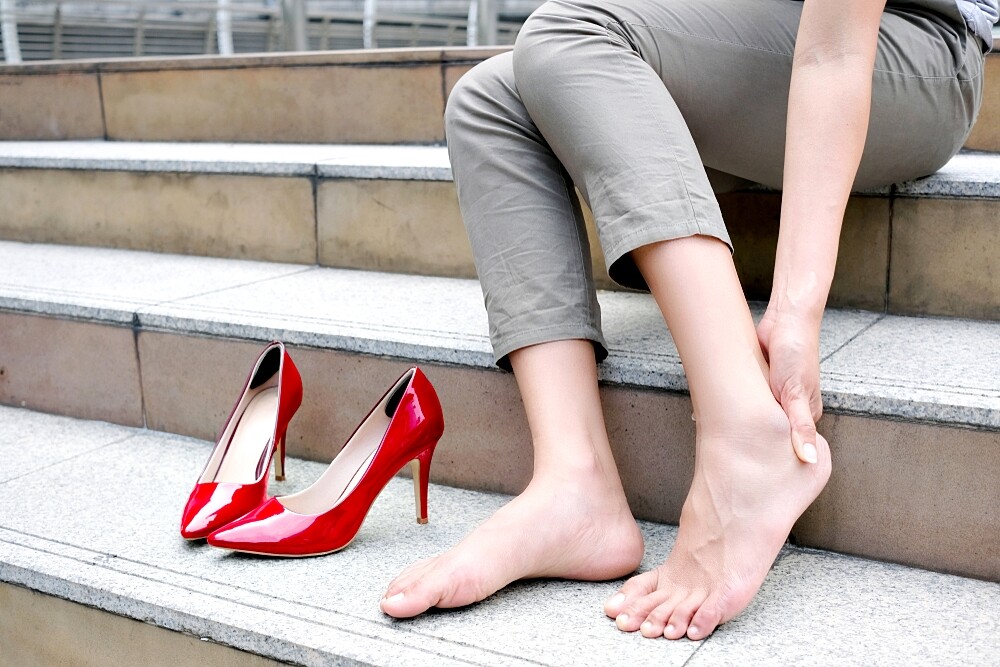The foot hurts when you step on it? There could be a heel spur behind it! We will show you here which treatment options are available and what you can do at home.
A heel spur on the foot can cause pain and make everyday life very uncomfortable – after all, our feet carry us everywhere and all day long. You can find out here what treatment is possible for heel spurs and what you can do yourself.
Heel spur: Origin and causes
The heel spur (calcaneus spur) is a bony outgrowth on the heel. It often affects the base of the tendon plate (plantar tendon), which extends towards the toes. In this case, doctors speak of a plantar heel spur. In contrast to the upper heel spur – the dorsal heel spur – which develops at the base of the Achilles tendon. The causes of a heel spur are manifold, it can be caused by overweight, poor footwear, incorrect weight bearing, a heavy load during sports or foot malpositions. But frequent, long walks or standing for long periods are also risk factors.
Symptoms
Stabbing or burning pain when the foot is strained is a symptom of heel spur, but the discomfort subsides after a resting phase. But also start-up pain in the morning or after a longer resting phase can occur.
Treatment and home remedies
The aim of the treatment should of course be to relieve the pain or to be pain-free and to prevent future heel pain! The treatment of a heel spur usually takes weeks, sometimes months.
Treatment options
- Shockwave therapy: This therapy is applied over a longer period of time, whereby shockwaves are directed to the affected area to stimulate blood circulation and cell metabolism. This should help the inflammation heal faster and reduce pain. Under certain circumstances, shock wave therapy is a benefit paid by the health insurance companies, otherwise they have to pay for it themselves.
- X-rays: The dose in radiation therapy is lower than in X-rays or cancer therapy. Here too, several sessions are necessary in several weeks. The therapy is considered free of side effects. Radiation is considered if other measures have not helped.
- Physiotherapy: Physiotherapy involves stretching the muscles and tendons on the sole of the foot. The physiotherapist trains appropriate exercises with you.
Nowadays, surgery is no longer the method of choice, and if it is, it is rather the exception. A cure is not guaranteed – and the heel spur can reappear.
What you can do yourself
- Insoles and shoes: Wear shoes that don’t restrict you and make sure you wear suitable footwear even when doing sports! Individually adapted insoles also support the foot and help to reduce stress.
- Cold: In acute pain, cold can help to alleviate it. For example, place a cool pack wrapped in a towel on the skin.
- Taping: This option does not fight the cause, but some people use taping to relieve the affected area. A second person is not absolutely necessary.
- Relief: If possible, avoid one-sided strain, give your feet enough rest and do warm-up exercises before the sport.
Exercises: Stretching exercises can help you with acute heel pain, but they can also be preventative. For this purpose, the exercises performed by the physiotherapist* should also be continued at home.
Heel sport treatment with exercises
Here we show you some exercises that can help with heel spurs. You should do these exercises about two to three times a day:
- Sit on the edge of the bed or a chair and now roll back and forth with the sole of your foot for a few minutes with a tennis ball.
- Hold on to a chair back and take a large step backwards with the affected foot. The front leg is bent. Now shift your body downwards to the front so that it pulls in the rear (stretched) leg. Hold this position for about 20 seconds.
- For this exercise you need a staircase: Stand on a step so that your heels protrude, i.e. hang in the air. Hold on to the railing! Now slowly lower your heels and hold them for 20 to 30 seconds.

